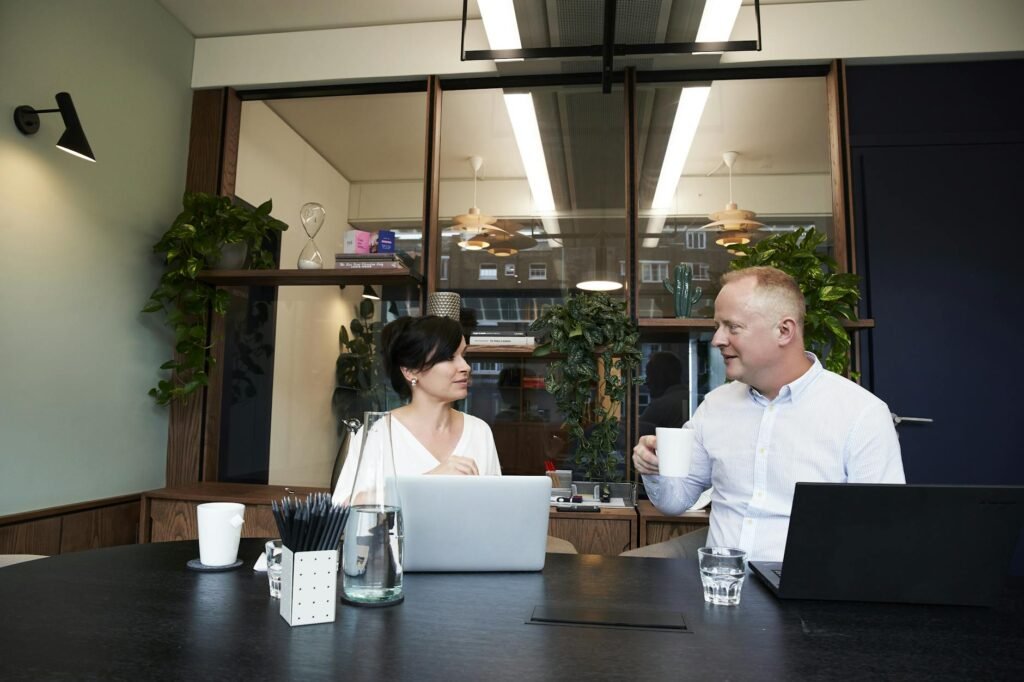Understanding Competitive Advantage
Standing out in the business crowd is a must, and let’s face it, it’s quite the race out there. Two ways that offer a head start are insights from Michael Porter and the Blue Ocean Strategy.
Michael Porter’s Strategy Insight
Michael Porter’s got some sharp thoughts. He warns against juggling too many balls at once, saying companies trying to mix several strategies might just have their cake and eat it too, but end up with crumbs. This means they might not fully benefit from any one strategy, letting competitors who focus more narrowly leave them in the dust. In Porter’s playbook, the idea of competitive advantage isn’t just a good idea, it’s gold. Companies going for cost leadership can attract those bargain hunters and boost profits with big sales numbers. Blocking new competitors also keeps them on top of the ladder. So, for businesses eyeing steady growth, picking a lane and sticking to it is key (Elevate Ventures).
Blue Ocean Strategy Concept
On the flip side, the Blue Ocean Strategy wants businesses to dive into untouched waters where competition is low. By steering clear of shark-infested waters of the usual markets, businesses can skip the price wars and sail into profitability. Innovation and creating fresh demand are the names of the game, helping companies stand out like a sore thumb in a good way, leaving others playing catch-up (Economic Times India).
Getting these strategies down pat is a big win for CEOs, business owners, and marketing folks aiming to carve out a strong position. By knowing both Porter’s tactics and the Blue Ocean Strategy, companies can whip up strategies that fit just right with their strengths and meet changing market needs.
For more on stepping up your game, check out our piece on types of competitive advantage. Grasping these ideas can lead to better choices and smart strategies for hitting it big over the long haul.
Advantages of Cost Leadership
Let’s break down how going after that cost leadership vibe can give a business a solid shot at grabbing the spotlight. Here’s the scoop on why cost leadership can be your ticket to winning big.
Attracting Price-Sensitive Customers
Cost leaders stand out by tossing out deals that just can’t be beat. Picture this: when the economy’s in a bit of a funk, everyone’s hunting for savings. That’s where cost leaders sweep in, grabbing those bargain-hunting customers and, bam, boosting their crowd size (EPAM SolutionsHub). Brands that nail cost leadership often capture a chunk of the market, just by being wallet-friendly.
Check out this table showcasing some rockstars of cost leadership:
| Company | Industry | Strategy Moves |
|---|---|---|
| McDonald’s | Fast-Food | Smart bulk buys, processes with no sweat |
| IKEA | Furniture Retail | Manufacturing with savvy, flat-pack wizardry |
Increased Profitability through High Sales Volumes
More customers mean more sales, and more sales mean money in the bank. The magic here is called economies of scale—sounds fancy but it’s all about making stuff cheaper when it’s done in big batches. Even when the profit margin per product’s tight, selling heaps can bulk up profits to impressive levels. And you know what? McDonald’s and IKEA are great at raking in those sweet, sweet profits with their efficient game plan (Faster Capital).
Building Barriers to Entry
Cost leadership also plays hard by setting up roadblocks for the competition. By keeping costs and prices low, they make it tough for newbies to jump in. Smaller start-ups often don’t have the deep pockets to duke it out in the cost ring. Old hands like McDonald’s and IKEA master this game, using slick operations and smart buying as their secret sauce to fend off newcomers (EPAM SolutionsHub).
In a nutshell, cost leadership is like a triple threat—bagging those price-watchers, upping the sales game, and putting a Do Not Enter sign for the competition. With these perks, businesses can rock the market long-term and stay ahead of the pack.
Successful Cost Leadership Examples
Cost leadership is a savvy game plan used by some of the world’s top players to snatch up big market shares without jacking up prices. Let’s dig into a few companies that have nailed this approach in different fields.
Walmart: Retail Industry
Walmart’s a big shot in retail, making waves as a cost leader. How do they pull it off? By running an ultra-efficient supply chain, buying in bulk, and scoring sweet deals with suppliers to keep customer prices low. This keeps Walmart on top in the bustling retail scene.
| Factor | Description |
|---|---|
| Supply Chain | Runs on efficiency, trimming any shipping hang-ups |
| Bulk Buying | Scores big savings per item through mass purchases |
| Market Share | A retail powerhouse with a vast global footprint |
Curious about how businesses keep a leg up on the competition? Check out competitive advantage in business.
Southwest Airlines: Low-Cost Airline Sector
Southwest Airlines shook up flying by slashing costs with smart strategies. They stick to one type of plane and ditch fancy extras, making it easy on the wallet for travelers wanting a fuss-free journey.
| Strategy | Description |
|---|---|
| Aircraft Type | Sticks to Boeing 737s for streamlined operations |
| Service Model | Keeps things basic to trim overheads |
| Customer Base | Caters to folks who fly on a budget |
Find out more about carving out a competitive spot in achieving competitive advantage.
McDonald’s: Fast-Food Industry
McDonald’s has the fast-food cost game down, thanks to its uniform processes, bulk buys, and lean operation tactics. This combo lets them whip up affordable meals while keeping customers happy worldwide.
| Approach | Description |
|---|---|
| Standardization | Consistent menus and cooking methods for uniform quality |
| Bulk Purchasing | Seals the deal with suppliers for budget-friendly ingredients |
| Global Reach | Spans the globe with thousands of outlets, leveraging economies of scale |
Dig into more savvy strategies by checking out sustainable competitive advantage examples.
IKEA: Furniture Retail
IKEA’s making waves in furniture retail by keeping it cheap and chic. Utilizing slick manufacturing, flat-pack shipping, and DIY assembly, they save a bundle, passing those savings onto customers.
| Feature | Description |
|---|---|
| Flat Packaging | Cuts costs by packing items tight for transit |
| Self-Service | You assemble, they save on labor |
| Manufacturer Efficiency | Smooth production processes that slash costs |
Want the scoop on how IKEA stays ahead? Discover more about their winning moves in competitive advantage strategies.
These tales of cost leadership spotlight how companies crush the competition by keeping costs down and smarts up across industries.
Market Resilience of Cost Leaders
Cost leaders are like the sturdy oak trees in the forest of business, standing strong against the wild gusts of market changes. They’ve got tricks up their sleeves to deal with everything, especially when the money belt tightens with economic dips.
Economic Downturn Adaptability
When wallets are on a diet, folks start hunting for savings like a squirrel in the fall. Enter cost leaders, who swoop in to grab the attention of shoppers on the prowl for bargains. Take Ryanair, for instance, flying high past the clouds of pricey competitors by running their airline as lean as a marathon runner at the tail end of a race. This mix of super-efficient operations and keeping costs in check means Ryanair can offer low-cost flights all over Europe, earning them a spot on the big airline leaderboard (EPAM SolutionsHub).
| Economic Factors | Impact on Cost Leaders |
|---|---|
| Increased Price Sensitivity | Score more customers with low prices |
| Reduced Disposable Income | Keep the sales wheel spinning with budget-friendly offerings |
| Shift from Brand Loyalty | Price wins the day over brand names in tight times |
Flexibility in Pricing Strategies
Being a cost leader means having the elasticity of a yoga master in prices, rolling with the punches and keeping an edge over the competition. This knack for tweaking prices helps them weather the tough storms of price wars and keep up when the market does its unpredictable dance. Low-cost airlines, for instance, juggle changes like going paperless and cutting down cabin staff to keep expenses down. Such tactics keep them light on their feet, ready to shift prices when the market plays hardball (Carbon Collective).
| Flexibility Factors | Benefits |
|---|---|
| Cost Management | Snappy changes when prices clash |
| Responsive Pricing | Quick shifts to chase market whims |
| Strategic Modifications | Forever finding ways to do things better and cheaper |
All in all, cost leaders ride out financial storms with the ease of a surfer on a good wave, staying competitive by bending and flexing their pricing strategies. Cracking this code helps any business that dreams of mastering a competitive advantage cost leadership strategy.
Things That Make Cost Leadership Work
For businesses eager to stand out by keeping costs low, several factors come into play. Running things smoothly, making smart decisions, and knowing the market are key to staying thrifty and profitable.
Smooth Sailing in Supply Chains
Keeping the supply chain humming is a must for cutting costs while boosting output. Take Walmart, for instance. They’ve got it down to an art, trimming fat with slick supply chain tricks. By keeping logistics tight, scoring sweet deals with suppliers, and leaning on tech, they make sure stuff gets to people without burning a hole in their wallet. This approach has helped them nab a bigger chunk of the market.
A nimble supply chain helps companies:
- Slash inventory costs
- Streamline operations
- Keep products in stock
Bigger Can Be Cheaper
When you ramp up production, costs per item often drop. Companies pulling this off can spread their fixed costs over more products, which drives down average expenses and amps up competitiveness.
| Business Name | Industry | Saving Secret |
|---|---|---|
| Walmart | Retail | Buying in bulk lowers supplier costs |
| McDonald’s | Fast-Food | Standardization slashes operational expenses |
| IKEA | Furniture | Efficient production and flat packing cut shipping costs |
IKEA’s game plan—efficient manufacturing and a DIY vibe—keeps their prices low worldwide, while still letting them offer trendy furniture options.
Teaming Up
Building strong ties with suppliers and other partners can offer a cost-cutting edge. By forming solid partnerships, businesses can snag better deals, get a leg up in service, and tap into high-grade resources. This teamwork helps firms keep costs in check while ensuring quality and reliability in stocking shelves.
Running Lean
Operational efficiency is key for those committed to cost leadership. Streamlining everything from making products to delivering them helps. Like Ryanair, with their no-frills approach, efforts focus on cutting operational costs. This lean setup lets them offer budget-friendly flights, securing their spot as major players in Europe’s airline scene.
By embracing these practices, companies can sharpen their edge and emerge as top dogs in their industries. For more ways to strengthen competitive strategies, check out our resources on competitive advantage strategies and building competitive advantage.
Cost Leadership Challenges
Takin’ the lead in offering lower prices sounds like a smart move, right? Well, it ain’t all sunshine and rainbows. Chasin’ a competitive edge with cost leadership comes with its own bag of issues. Let’s chew over some of the hurdles that businesses might stumble upon when goin’ down the cost-cutting path.
Quality vs. Cost Tug-O-War
One major hiccup with keepin’ prices low is the quality-versus-cost showdown. Imagine you’re juggling; sometimes to keep costs down, you might drop a ball—resultin’ in subpar products or services. This might leave customers grumblin’, unsatisfied, and tarnishin’ the good ol’ company name. Folks aren’t lookin’ just for cheap stuff; they want goods that make ’em feel they got a steal of a deal.
The Tech Dinosaur Risk
Ever seen a business stuck in a time warp, clingin’ to old tech like it’s goin’ outta style? Well, businesses focused solely on cost-cutting might turn into tech dinosaurs, ignorin’ the need to innovate. This reluctance to update can shrink their ability to keep up with snazzy trends and what customers are hankerin’ for. Gettin’ too cozy with cheapness ain’t just about the bucks—ya gotta be in the know and ready to shake it up a bit.
Supplier Handshake Jitters
Here’s the skinny: Dependin’ heavily on your suppliers can be risky business. Good deals with suppliers sound nice till they start jackin’ up prices or messin’ with quality. This sorta ruckus in the supply chain can mess up that cost advantage, threatenin’ the whole stability of the gig. That’s where the balancing act turns real wobbly.
| Challenge | Explanation |
|---|---|
| Quality vs. Cost Tug-O-War | Keeping prices low may lead to poor quality and upset customers. |
| The Tech Dinosaur Risk | Obsessing over costs might sideline innovation and tech updates. |
| Supplier Handshake Jitters | Heavy reliance on suppliers can lead to unexpected troubles. |
Down-n-Dirty Price Bust-Ups
Gettin’ good at cuttin’ costs can draw in other players wantin’ a slice of the low-price pie. Next thing you know, you’re knee-deep in price battles, fightin’ to keep your costs as the lowest. Stayin’ on top isn’t just about watchin’ the pennies; it’s about holdin’ ground when others step up to the plate with similar low-budget goods. The tricky part? Without standout features, keepin’ folks loyal to your brand gets real dicey.
All in all, clockin’ these challenges is no trivial pursuit for CEOs and other big guns in the biz world. Takin’ these hurdles head-on while hangin’ onto cost leadership can reel in lasting success in a rough-n-tumble market. Want more on stayin’ ahead of your competition? Check out our article on competitive advantage strategies.
Differentiation vs. Cost Leadership
When businesses look to outshine their rivals, they usually ponder over two main strategies: standing out or cutting costs. Knowing the quirks of each can help CEOs, business owners, and marketing pros decide the best path forward.
Unique Selling Points
Differentiation is all about being the special snowflake in a blizzard of companies. Businesses that excel in this space create products and services with features and benefits that make them stand out. Think of Apple’s sleek gadgets, BMW’s luxury cars, or Nike’s innovative sportswear (i7 Marketing). These brands have carved out niches by offering something extra that customers can’t resist.
Meanwhile, cost leaders like Ryanair keep things bare-bones to offer rock-bottom prices, stripping away all the fancy stuff to cut costs (EPAM SolutionsHub). This strategy appeals to wallet-conscious customers who just want to get where they’re going, no bells or whistles needed. It’s a pick-and-choose world out there—some folks want the latest gadgets and luxury, while others just want a good deal.
| Strategy | Traits | Sample Brands |
|---|---|---|
| Differentiation | Fancy features, premium tags | Apple, BMW, Nike |
| Cost Leadership | Cheap deals, plain goods | Ryanair, Walmart |
Keeping Customers Hooked
Each strategy brings its own set of challenges in making customers stick around. If a company relies on unique offerings, they’ve usually got loyal fans who love their special features or top-notch quality. But here’s the catch—if they stop innovating or evolving, their fans might jump ship to the next big thing.
For cost-saving companies, loyalty is more about the dollar than the brand. Price-sensitive buyers might be quick to switch for a better bargain elsewhere. As the market heats up with competing prices, staying ahead in the game might mean constantly cutting costs to the bone.
For folks in charge of steering a company through these waters, understanding what makes these strategies tick is crucial. Finding that sweet spot between being unique and being cheap could mean the difference between staying ahead or falling behind. Curious to learn more about crafting a killer strategy? Check out the article on competitive advantage strategies.
Future Trends in Cost Leadership
Business folks, finding ways to stay ahead is like trying to surf the big waves—you gotta understand all the twists and turns! Let’s talk about the latest trends in cost leadership. This section chats about why making your products like peas in a pod is a smart move, and how keeping on your toes with the market dance is a must.
Product Standardization Considerations
When you get down to brass tacks, making your products all neat and tidy like each other isn’t just smart—it’s essential. Think of it as turning your factory into one of those well-oiled machines people talk about. When you keep your products similar, you’re not only cutting down the dough you spend making stuff, but also making life easier when it comes to keeping track of what you’ve got.
Now, when it comes to blowing your own trumpet on promotions, sticking with a few good channels is the way to go. It’s like focusing your spotlight instead of lighting up the whole forest—a little goes a long way and the audience decides quicker whether to clap their hands and buy what you’re selling. Just don’t tie everything up in a neat bow and forget what your customers are after. Too much of the same old can become a real yawner if it doesn’t hit home with the folks you’re selling to.
Adaptation to Market Changes
The market’s like a chameleon—forever changing. You have to be quick to hit those curveballs and stay in the game with cost leadership. Watch out for what consumers are buzzing about, skip the tech flop, and keep your eyes peeled on what the competition’s up to. Ignoring changes and sticking to bare-bones cost cutting might mean you’re left behind in the tech dance. Companies that skimp on research might find themselves trying to press fast-forward just to keep up.
A smart business move is to make pals with your suppliers—it’s like arranging a deal at the local market, except way bigger! Better deals, better terms, and less chance of supply hiccups messing up your plans are all part of the package.
But don’t drop the ball on quality just to keep those costs low. Remember, reputation’s everything, and once it’s scratched, it’s hard to shine again. Folks won’t stick around if what you’re offering doesn’t meet the mark. It’s about balancing the price while keeping your goods top-notch to keep those customers coming back.
If businesses get the hang of making things standard and reacting quickly to changes, they’ll be cruising through with cost leadership. For sipping more wisdom tea on competitive edge, check out our chit-chat on competitive advantage strategies and sustainable competitive advantage examples.




















